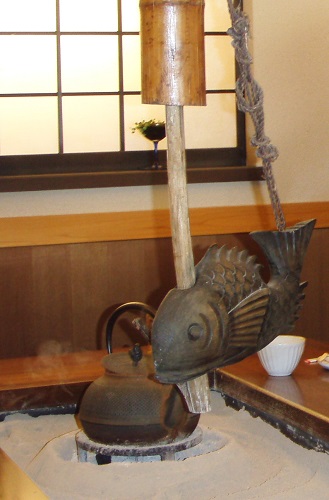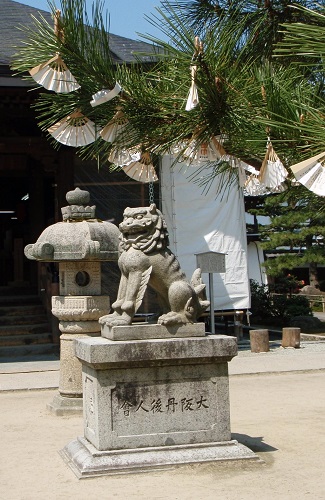Partway up the hill we came across a small, grassy plateau. A row of people stood in silence, bent double with their heads between their legs. Coloured banners flapped in the breeze, each adorned with a cartoon-like character demonstrating the same inverted pose. We joined the line, turned our backs to the sea and assumed the position. The blood rushed to our heads as we took our time appreciating the view, a verdant column protruding up across the calm sea to the sky above. We began to understand why the pine-covered sandspit was called Amanohashidate, the bridge to heaven.

Viewing The Bridge To Heaven
Nariaiji Temple
We continued along the dusty dirt track that wound up the side of the hill, distracted from the path by the black kites soaring overhead. A short time later, we arrived at Nariaiji temple and found it largely deserted. Apparently most tourists don't venture beyond the Amanohashidate viewpoint. In the main hall, we met one of the temple's monks, shaven headed and clad in a simple robe. Keen to chat, he pointed out a wooden carving of a dragon above us. No matter where we went, the unnerving gaze of this all-seeing monster followed us around the room.

The All-Seeing Dragon
The monk invited us to shake the hand of a statue of Kannon, the Goddess of Mercy. Several rainbow-coloured strands of string connected the statue's delicate hand with larger ribbons hanging from the ceiling. Tug on the ribbons and you were effectively shaking hands with the statue. It was quite an honour given that the cabinet containing this dainty figure would be closed the following week and remain closed for the next 25 years.
Crossing Amanohashidate, The Bridge To Heaven
We made our way downhill to the sandspit known as Amanohashidate. Stretching across the bay, it made a convenient and scenic short cut to Monju village on the other side. We walked through the forest on a carpet of pine needles, appreciating the tranquillity as the water lapped gently on both shores. Three kilometres and around 7000 pine trees later, we hadn't made it to heaven but we had reached the bridge at the other end. We watched the unusual rotating bridge in action as we waited to cross. The operator pivoted the bridge a full 90 degrees to make way for a boat passing through.

The Revolving Bridge
Gaining Wisdom In Monju
Finally crossing the bridge, we spotted several ladies slowly circling a large stone ring atop a pillar. We followed suit. After three laps of Chie no wa Toro, the lantern of wisdom, we rested our heads in the centre of the ring, hoping for endowment with knowledge. Just to be sure, we also visited the adjacent temple of Chionji, dedicated to the Buddhist god of wisdom and intellect, Monju.
We stopped for a cup of matcha at a quiet teahouse. Relaxing on tatami mats around a traditional fire pit, we watched as the fine green powder was whisked into a pale frothy tea. The warming but bitter beverage was perfectly complemented by yet another source of wisdom, Chie no Mochi, glutinous rice cakes smothered in sweet red bean paste.
Walking a short way up the hill, we came to Chie no Yu onsen, a Japanese bathhouse. Unsurprisingly perhaps, the 'Hot Springs of Wisdom' promised increased intellect along with good health and beauty. We soaked our tired feet in the round stone foot bath outside. The warm, steamy pool was so full of minerals, you could literally smell the health benefits.

Making Tea
Although it's best known for the view over the sandspit, which must of course be appreciated from the correct position, there is more to Amanohashidate for those willing to take their time. Most of the attractions in Monju centre around the village's namesake, who is the god of wisdom. Although particularly popular with students studying for exams, we saw people of all ages eating wisdom cakes, circling the lantern and praying to Monju at the temple. So, did we end up any wiser? Perhaps wise enough not to say.
The Three Most Scenic Views In Japan
Amanohashidate is one of the Nihon Sankei, the top three scenic spots in Japan. The other two are Miyajima, with its torii gate floating in the sea, and Matsushima Bay peppered with tree-clad islands.
Amanohashidate Travel Tips
In summer, Amanohashidate can be very busy. During cherry blossom season however, any self-respecting Japanese person will be travelling to see this most transient of spectacles. As there are no cherry trees on the sandbar, late March / early April is a quiet time to visit Amanohashidate.
There are several spacious picnic areas on the sandspit. There are no shops however, so bring your picnic supplies with you.
How To Get To Amanohashidate
Take the Hashidate Limited Express train directly from Kyoto station to Amanohashidate.
Take a bus from Kyoto station, Hankyu Umeda station or Shin Osaka station.

